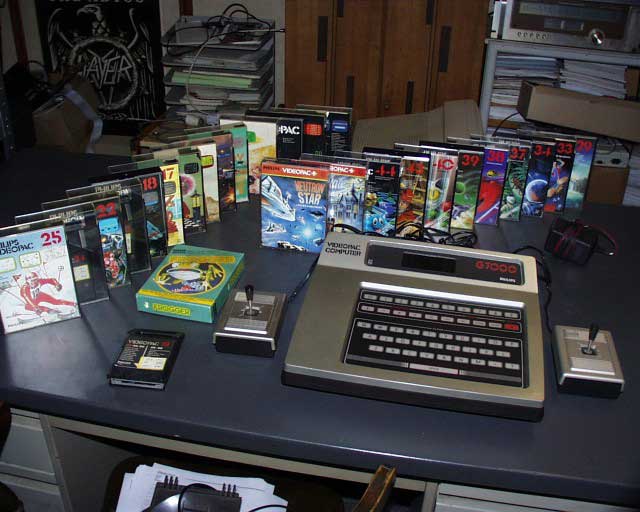In 1976 Fairchild Electronics came up with the idea of using ROM
(read-only memory) cartridges for their own "Channel-F" videogame system.
With this innovation, each videogame could be completely unique; however
their game system was too primitive and never caught on.
The big news, however was just ahead: By December 1977 Atari released the
programmable Video Computer System, the Atari VCS
(which was later renamed the Atari 2600.)
Readers of this essay are undoubtably familiar with this system; more
description would be superfluous.
RCA also released their own home video game system this same year,
the "Studio II".
For some reason they decided to release a machine that was only capable
of producing black and white images, which did not go over well with the
consumers in home electronics marketplace.
A European G7000. Looks slightly different from its american counterpart,
the Odyssey˛.
Near the same time, in early 1977, Maganox had developed a non-programmable
game console that they called the Odyssey 2.
It would not have the ability to add new games through cartridges, but
instead would have 24 built in games, and allow up to four people to play
simultaneously.
Soon afterward, however, the videogame market became crowded with a number
of other enteries all of which had to compete not only with each other, but
also with the large number of inexpensive hand held electronic games.
The resulting market difficulties convinced Magnavox not to market this
incarnation of the 24-game Odyssey 2.
To date, I am not aware of any classic videogame collectors who own a
prototype of this unit.
In 1978 Magnavox released a new videogame system for the home market:
The Odyssey˛.
This new unit bore no relation to the scapped 24-game system.
Instead, it was a fully programable home video game systerm that was designed
to use 2K ROM game cartridges.
Like the Atari VCS, the CPU of the O˛ was powerful enough such that each
game could be a completely unique experience, with its own background
graphics, foreground graphics, gameplay, scoring and music.
The potential was enormous, as an unlimited number of games could be
individually purchased.
Like the Atari 2600, the Odyssey˛ allowed any game player to purchase a
library of videogames tailored to his or her own interest.
Unlike any other system at that time, the Odyssey˛ also included a full
alpha-numeric touchpad keyboard, which was to be used for educational games,
selecting game options or programming. This was a major selling point of
the system.
For hand held controllers, the Odyssey˛ utilized the classic joystick design
of the 1970s and 80s: A moderately sized, self centering eight way joystick.
It was held in the left hand, and manipulated with the right hand.
In the upper corner of the joystick was a single 'Action' button.
A credit to the designers at Maganavox, three or four years later, with Atari,
Intellivision, and a number of third party companies producing hardware,
many people still felt that the Odyssey˛ joystick was one of the best designed.
Some games in various boxes: hard plastic, the strange "Laufschrift"-
cartridge "A" and a paper box.
By 1981, Atari and Intellivison sales had grown in leaps and bounds beyond
the O˛.
Nevertheless, unlike some unnamed videogame companies, (hint: their name
rhymes with Vega) Philips kept on supporting the O˛.
Their programmers's slow but steady improvements in gameplay and graphics
made sure that O˛ owners could always count on more and better games being
made available.
Even without massive third party support, by 1983 over a million O˛ units
were sold in North America alone.
It is less well known that the Odyssey˛ was even more popular in Europe,
where it was marketed by Magnavox's parent company, Philips Electronics.
In Europe (and in other parts of the world as well) the O˛ was sold as the
Philips G7000 Videopac console. In France, it was known as the Philips C52.
In Brazil it was known as the Odyssey, as the original Odyssey was never
released in Brazil
www.thepong.com
|


